- Control Structure
- Assembly deployment
- Adding WinUI SfColorPalette via XAML
- Adding WinUI SfColorPalette via C#
- Accessing a Color programmatically
- Select color from color palette
- Add your own color in the Theme and Standard color palette
- Recently used color items
- Choosing a color from MoreColor dialog
- Reset the selected color
- Selected color changed notification
Contact Support
Getting started with WinUI SfColorPalette
This section explains how to create a WinUI SfColorPalette and explains about its structure and features.
Control Structure
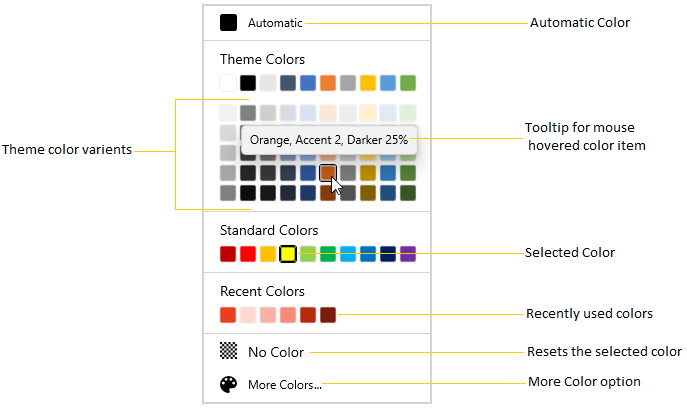
-
The Selected Color represents the color that you select.
-
The Automatic Color represents the Color, which can be set by you as default color.
-
The ToolTip with Color Details represents the ToolTip, when the mouse hovers on the Color.
-
The Standard Colors stores the standard colors like
Red,Green,Blueand so on. -
The Recently User Colors stores the Colors that are recently selected.
-
The No Color represents the
Transparentcolor that applied as the selected color. -
The More Colors Option provides wide range of color in addition to colors in the palette.
-
The Theme Variant Colors represents the Theme colors with variants.
More Color Dialog

Assembly deployment
Refer to the control dependencies section to get the list of assemblies or NuGet package that needs to be added as reference to use the control in any application.
You can find more details about installing the NuGet package in a WinUI application in the following link:
How to install nuget packages
Adding WinUI SfColorPalette via XAML
To add the SfColorPalette control manually in XAML, follow these steps:
-
Create a new WinUI project in Visual Studio.
- Add the following assembly references to the project,
- Syncfusion.Core.WinUI
- Syncfusion.Editors.WinUI
-
Import Syncfusion WinUI schema using:Syncfusion.UI.Xaml.Editors and declare the
SfColorPalettecontrol in XAML page. - Declare the
SfColorPalettecontrol in XAML page.
<Page
x:Class="ColorPalette_Sample.MainPage"
xmlns="http://schemas.microsoft.com/winfx/2006/xaml/presentation"
xmlns:x="http://schemas.microsoft.com/winfx/2006/xaml"
xmlns:local="using:ColorPalette_Sample"
xmlns:d="http://schemas.microsoft.com/expression/blend/2008"
xmlns:mc="http://schemas.openxmlformats.org/markup-compatibility/2006"
xmlns:syncfusion="using:Syncfusion.UI.Xaml.Editors">
<Grid>
<!--Adding SfColorPalette control -->
<syncfusion:SfColorPalette Margin="10"
Name="sfColorPalette"/>
</Grid>
</Window>Adding WinUI SfColorPalette via C#
To add the SfColorPalette control manually in C#, follow these steps:
-
Create a new WinUI application via Visual Studio.
- Add the following assembly references to the project,
- Syncfusion.Core.WinUI
- Syncfusion.Editors.WinUI
-
Include the required namespace and create an instance of
SfColorPaletteand add it to the window. - Declare the
SfColorPalettecontrol using C#.
using Syncfusion.UI.Xaml.Editors;
public sealed partial class MainPage : Page {
public MainPage() {
this.InitializeComponent();
//Creating an instance of SfColorPalette control
SfColorPalette sfColorPalette = new SfColorPalette();
//Adding SfColorPalette as window content
this.Content = sfColorPalette;
}
}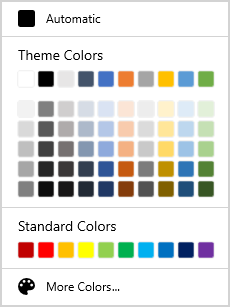
Accessing a Color programmatically
You can set or change the selected color of the SfColorPalette programmatically by setting the value to SelectedBrush property. You can also get the selected color by using the SelectedBrush property. The default value of SelectedBrush property is Transparent(#00FFFFFF).
<syncfusion:SfColorPalette SelectedBrush="Yellow"
Name="sfColorPalette" />
<Button Background="{Binding ElementName=sfColorPalette, Path=SelectedBrush}"></Button>sfColorPalette.SelectedBrush = new SolidColorBrush(Colors.Yellow);
Here, Yellow color is selected color in the SfColorPalette.
Select color from color palette
You can select a different colors from Theme Color and Standard Color panels. You can show or hide the variant colors of the base Theme Colors and Standard Colors by using the PaletteColors.ShowColorShades and StandardColors.ShowColorShades properties value as true or false.
<syncfusion:SfColorPalette Name="sfColorPalette">
<syncfusion:SfColorPalette.PaletteColors>
<syncfusion:ColorPaletteModel ShowColorShades="True"/>
</syncfusion:SfColorPalette.PaletteColors>
<syncfusion:SfColorPalette.StandardColors>
<syncfusion:StandardPaletteModel ShowColorShades="True"/>
</syncfusion:SfColorPalette.StandardColors>
</syncfusion:SfColorPalette>sfColorPalette.PaletteColors.ShowColorShades = true;
sfColorPalette.StandardColors.ShowColorShades = true;
Add your own color in the Theme and Standard color palette
If you want to apply custom colors for base Theme Colors and Standard Colors palette, add the colors into the PaletteColors.Colors and StandardColors.Colors collections. The varient colors will be automatically created for the own Theme and Standard Colors.
<syncfusion:SfColorPalette Name="sfColorPalette">
<syncfusion:SfColorPalette.PaletteColors>
<syncfusion:ColorPaletteModel ShowColors="True"
ShowColorShades="True"
Header="Custom Theme Colors" >
<syncfusion:ColorPaletteModel.Colors>
<syncfusion:ColorCollection>
<syncfusion:ColorModel Color="#FF11EBF8" Tooltip="Custom Aqua" />
<syncfusion:ColorModel Color="#FFF80FA6" Tooltip="Custom Deep Pink" />
<syncfusion:ColorModel Color="#FF8BA7C2" Tooltip="Custom Dark Gray" />
<syncfusion:ColorModel Color="#F53CDF07" Tooltip="Custom Lime Green" />
<syncfusion:ColorModel Color="#C2929545" Tooltip="Custom Olive Drab" />
<syncfusion:ColorModel Color="#2E956145" Tooltip="Custom Sienna" />
<syncfusion:ColorModel Color="#78458E95" Tooltip="Custom Steel Blue" />
<syncfusion:ColorModel Color="#8B8220E4" Tooltip="Custom Blue Violet" />
<syncfusion:ColorModel Color="#FF352722" Tooltip="Custom Dark Slate Gray" />
<syncfusion:ColorModel Color="#FF318B86" Tooltip="Custom Sea Green" />
</syncfusion:ColorCollection>
</syncfusion:ColorPaletteModel.Colors>
</syncfusion:ColorPaletteModel>
</syncfusion:SfColorPalette.PaletteColors>
<syncfusion:SfColorPalette.StandardColors>
<syncfusion:StandardPaletteModel ShowColors="True"
ShowColorShades="True"
Header="Custom Standard Colors" >
<syncfusion:StandardPaletteModel.Colors>
<syncfusion:ColorCollection>
<syncfusion:ColorModel Color = "Blue" Tooltip = "Custom Blue" />
<syncfusion:ColorModel Color = "Orchid" Tooltip = "Custom Orchid" />
<syncfusion:ColorModel Color = "Gray" Tooltip = "Custom Gray" />
<syncfusion:ColorModel Color = "Gold" Tooltip = "Custom Gold" />
<syncfusion:ColorModel Color = "SandyBrown" Tooltip = "Custom SandyBrown" />
<syncfusion:ColorModel Color = "Pink" Tooltip = "Custom Pink" />
<syncfusion:ColorModel Color = "Violet" Tooltip = "Custom Violet" />
<syncfusion:ColorModel Color = "Yellow" Tooltip = "Custom Yellow" />
<syncfusion:ColorModel Color = "Orange" Tooltip = "Custom Orange" />
<syncfusion:ColorModel Color = "Red" Tooltip = "Custom Red" />
</syncfusion:ColorCollection>
</syncfusion:StandardPaletteModel.Colors>
</syncfusion:StandardPaletteModel>
</syncfusion:SfColorPalette.StandardColors>
</syncfusion:SfColorPalette>sfColorPalette.PaletteColors.Header = "Custom Theme Colors";
sfColorPalette.PaletteColors.ShowColors = true;
sfColorPalette.PaletteColors.ShowColorShades = true;
sfColorPalette.StandardColors.Header = "Custom Standard Colors";
sfColorPalette.StandardColors.ShowColors = true;
sfColorPalette.StandardColors.ShowColorShades = true;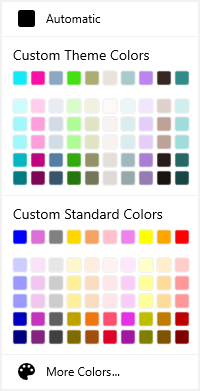
Recently used color items
The recently selected color items are displayed in the Recent color panel. If you want to choose a color which are previously selected, use the Recent color panel. You can get the recently used color list from the RecentColors collection.
NOTE
Colors selected from theme and standard colors will not be added in recent colors.
<syncfusion:SfColorPalette Name="sfColorPalette"/>//Getting the recently used color list
var recentColors = sfColorPalette.RecentColors;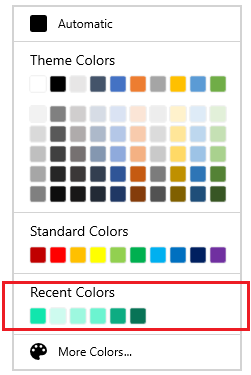
Choosing a color from MoreColor dialog
If you want to choose a color that is not available in palette, click the more color button and select the color from color spectrums and click the Ok button.
<syncfusion:SfColorPalette ShowMoreColorsButton="true"
Name="sfColorPalette"/>sfColorPalette.ShowMoreColorsButton = true;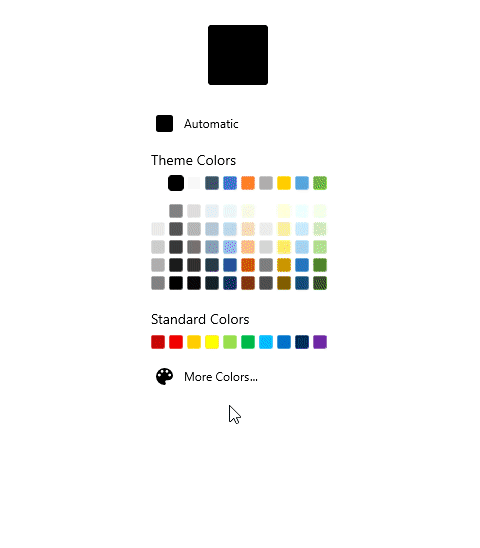
Reset the selected color
If you want to reset the selected color as No color or Transparent, click the No Color button. You can display the
No color button only by setting the ShowNoColorButton property value as true. The default value of ShowNoColorButton property is false.
<syncfusion:SfColorPalette ShowNoColorButton="True"
Name="sfColorPalette"/>sfColorPalette.ShowNoColorButton = true;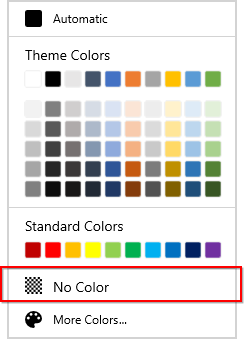
Selected color changed notification
The selected color changed in SfColorPalette can be examined using SelectedBrushChanged event. The SelectedBrushChanged event contains the old and newly selected color values in the OldBrush, NewBrush properties.
<syncfusion:SfColorPalette SelectedBrushChanged="SfColorPalette_SelectedBrushChanged"
Name="sfColorPalette" />sfColorPalette.SelectedBrushChanged += SfColorPalette_SelectedBrushChanged;//Invoked when the selected color is changed
private void SfColorPalette_SelectedBrushChanged(object sender, SelectedBrushChangedEventArgs e) {
var oldBrush= e.OldBrush;
var newBrush= e.NewBrush;
}